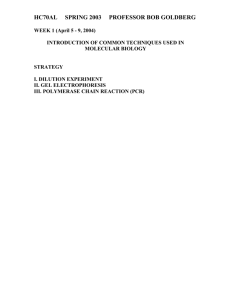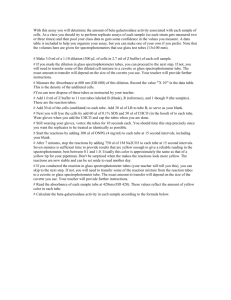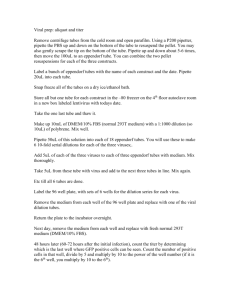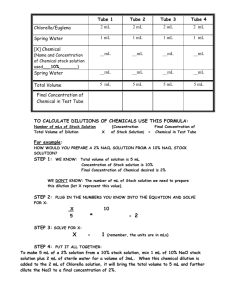Quantitative Analysis of Microbes – Bacterial Counts
advertisement
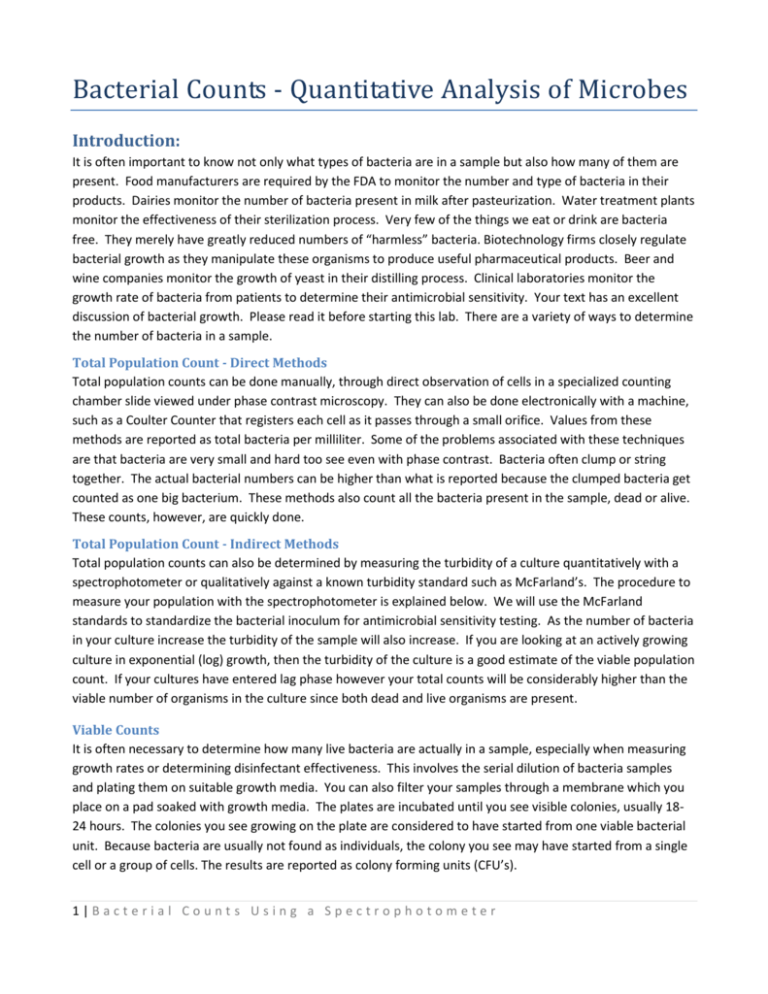
Bacterial Counts - Quantitative Analysis of Microbes Introduction: It is often important to know not only what types of bacteria are in a sample but also how many of them are present. Food manufacturers are required by the FDA to monitor the number and type of bacteria in their products. Dairies monitor the number of bacteria present in milk after pasteurization. Water treatment plants monitor the effectiveness of their sterilization process. Very few of the things we eat or drink are bacteria free. They merely have greatly reduced numbers of “harmless” bacteria. Biotechnology firms closely regulate bacterial growth as they manipulate these organisms to produce useful pharmaceutical products. Beer and wine companies monitor the growth of yeast in their distilling process. Clinical laboratories monitor the growth rate of bacteria from patients to determine their antimicrobial sensitivity. Your text has an excellent discussion of bacterial growth. Please read it before starting this lab. There are a variety of ways to determine the number of bacteria in a sample. Total Population Count - Direct Methods Total population counts can be done manually, through direct observation of cells in a specialized counting chamber slide viewed under phase contrast microscopy. They can also be done electronically with a machine, such as a Coulter Counter that registers each cell as it passes through a small orifice. Values from these methods are reported as total bacteria per milliliter. Some of the problems associated with these techniques are that bacteria are very small and hard too see even with phase contrast. Bacteria often clump or string together. The actual bacterial numbers can be higher than what is reported because the clumped bacteria get counted as one big bacterium. These methods also count all the bacteria present in the sample, dead or alive. These counts, however, are quickly done. Total Population Count - Indirect Methods Total population counts can also be determined by measuring the turbidity of a culture quantitatively with a spectrophotometer or qualitatively against a known turbidity standard such as McFarland’s. The procedure to measure your population with the spectrophotometer is explained below. We will use the McFarland standards to standardize the bacterial inoculum for antimicrobial sensitivity testing. As the number of bacteria in your culture increase the turbidity of the sample will also increase. If you are looking at an actively growing culture in exponential (log) growth, then the turbidity of the culture is a good estimate of the viable population count. If your cultures have entered lag phase however your total counts will be considerably higher than the viable number of organisms in the culture since both dead and live organisms are present. Viable Counts It is often necessary to determine how many live bacteria are actually in a sample, especially when measuring growth rates or determining disinfectant effectiveness. This involves the serial dilution of bacteria samples and plating them on suitable growth media. You can also filter your samples through a membrane which you place on a pad soaked with growth media. The plates are incubated until you see visible colonies, usually 1824 hours. The colonies you see growing on the plate are considered to have started from one viable bacterial unit. Because bacteria are usually not found as individuals, the colony you see may have started from a single cell or a group of cells. The results are reported as colony forming units (CFU’s). 1|Bacterial Counts Using a Spectrophotometer Plate Count Procedure There are several methods commonly used for plate counting bacteria: pour plate, overlay plate, and surface count. For the pour and overlay method the bacterial sample is suspended in molten agar that is just barely warm enough to keep the agar from setting up. It is then poured into an empty Petri dish or poured in a thin layer on another agar surface. The advantages of these methods are that the colonies stay small and compact. You can count plates with a lot higher concentration because the colonies will not be touching one another. The main disadvantage is the difficulty in keeping the agar hot enough to keep it from setting up until you pour it and cool enough to not heat shock or kill you bacteria! The surface count plate method gives reliable and consistent results. It is far easier to use, especially for beginning microbiology students! You pipette a small volume of bacteria onto the surface of a plate and spread it evenly around the surface. It is also useful if you are using selective media because you do not obtain the same color responses when the bacteria are growing in the agar because of the different oxygen requirements. Before you do any of this however, you need to dilute down any bacterial culture that has visible turbidity. Refer to the Serial Dilution Procedure for this. Turbidity Measurements You often need quicker results to determine the number of bacteria in a sample. If you have a culture growing in log phase you can use the plot of broth turbidity with a known viable colony count. You can use this graph to determine the number of viable bacteria in another culture grown under the same conditions that you created your graph with. You can plot the optical density on the y-axis against the concentration on the log xaxis. Any point along the straight portion of the line can be used to calculate the viable cell count from that dilution factor. This is extremely helpful in the biotech industry where actively grown cultures are routinely used. Materials: 6 – 13x100mm disposable test tubes and analog/digital spectrophotometer 6 – 3mL disposable cuvettes and Genesys20 spectrophotometer 1 tube sterile TSB broth 5mL pipettes with green pipette aid 1mL pipettes with blue pipette aid 1 broth culture of organism Procedure: There are several different brands of spectrophotometers available in the lab. Your instructor will direct you to which one you will use. The basic method for using them is all same. Two of them are analog machines, two of them are digital machines, and two of them are Genesys20 machines. The analog and digital spectrophotometers take 15-30 minutes for the bulbs to warm up and give stable readings. The Genesys20 spectrophotometers take 5-10 minutes for the bulbs to warm up and give stable readings. Turn the machines on while you are doing your serial dilutions. Set the wavelength to 696nm. 2|Bacterial Counts Using a Spectrophotometer Serial Dilutions The serial dilutions you will perform for turbidity measurements follow the same principle as those you did for the plate count. Look at your third tube or bottle. Can you see anything in there? If you can’t, the machine can’t either. You will be doing a different series of dilutions for this procedure that are not as dilute as what you plated previously. Option1: Using an analog/digital spectrophotometer and 13X100mm disposable test tubes 1. Obtain 6 empty 13X100 disposable test tubes. Add 4mL of plain sterile media to a tube labeled blank. This is the tube you will use to “tell” the machine what the background color is. You want the machine to see your bacteria not your media. Be sure to label up at the very top of the tube. 2. Label your remaining tubes 1:1, 1:2, 1:4, 1:8, 1:16. In the serial dilutions we did for our plate counts, we were doing 1:100 dilutions between the tubes or bottles. Here you are doing a 1:2 dilution between each tube (except for the first one which is your undiluted culture sample). 3. In the 1:1 tube, add 4mL of your original broth culture. You need this much volume in the tube for the light path of the machine. 4. In the remaining 4 tubes add 4mL of plain sterile broth (no organism). Be sure to use a new, sterile pipette. This is your diluent. 5. Using a 5mL pipette, add 4mL of your original broth sample into the 1:2 tube. Mix the contents together by sucking up and then expelling the contents at least three times. 6. Withdraw 4mL from the 1:2 tube and add it to the 1:4 tube. Repeat the mixing procedure. 7. Repeat this procedure for the next two tubes. Draw from the concentrated one to the next dilution and mix. Your final tube will have 8mL in it. Just leave it with the greater volume; it will not interfere with your readings. Optical Density Measurement: Be sure the outside of your tubes are free from drips or finger smudges. You want the machine to measure the turbidity of your sample not your glassware! You can wipe the tubes off with a Kimwipe if they are dirty. Review the operation of the spectrophotometer if you have forgotten how to use them. 1. Set the 0% transmittance or maximum absorbance with nothing in the tube holder. Be sure the lid is closed. This is an electronic baseline for the machine. Use the left knob. 2. Place your tube with the uninoculated broth blank in the tube holder, close the lid, and zero out the background absorbance/transmittance of the broth diluent. Use the right knob. 3. Insert your serially diluted tubes and record the absorbance directly from the machine. Option1: Using an analog/digital spectrophotometer and 13X100mm disposable test tubes 1. Obtain 6 empty cuvettes. Add 2mL of plain sterile media to a tube labeled blank. This is the tube you will use to “tell” the machine what the background color is. You want the machine to see your bacteria not your media. Be sure to label up at the very top of the tube. 2. Label your remaining cuvettes 1:1, 1:2, 1:4, 1:8, 1:16. In the serial dilutions we did for our plate counts, we were doing 1:100 dilutions between the tubes or bottles. Here you are doing a 1:2 dilution between each tube (except for the first one which is your undiluted culture sample). 3|Bacterial Counts Using a Spectrophotometer 3. In the 1:1 cuvette, add 2mL of your original broth culture. You need this much volume in the tube for the light path of the machine. 4. In the remaining 4 tubes add 1mL of plain sterile broth (no organism). Be sure to use a new, sterile pipette. This is your diluent. 5. Using a 1mL pipette, add 1mL of your original broth sample into the 1:2 tube. Mix the contents together by sucking up and then expelling the contents at least three times. 6. Withdraw 1mL from the 1:2 tube and add it to the 1:4 tube. Repeat the mixing procedure. 7. Repeat this procedure for the next two tubes. Draw from the concentrated one to the next dilution and mix. Your final tube will have 2mL in it. Just leave it with the greater volume; it will not interfere with your readings. Optical Density Measurement: Be sure the outside of your cuvettes are free from drips or finger smudges. You want the machine to measure the turbidity of your sample not your cuvetes! You can wipe the cuvettess off with a Kimwipe if they are dirty. Review the operation of the spectrophotometer if you have forgotten how to use them. 1. Place your cuvette with the uninoculated broth blank into the cuvette holder, shut the lid, and zero out the background absorbance/transmittance of the broth diluents by pressing the blank button. 2. Insert your serially diluted cuvettes and record the absorbance directly from the machine. Determining a Viable Count for an Unknown Culture Using OD Values Use Microsoft Excel on the computers to make a table and graph of your data. 1. Make a scatter graph. Use the y-axis, non-log, for the absorbance data plotted in OD units (0-2). Remember that absorbance increases as the number of bacteria increases. On the x-axis plot the dilution factors: 1, 0.5 (1:2), 0.25 (1:4), 0.125 (1:8) and 0.0625. 2. Add a trendline to your scatter graph. 3. Since you know the number of CFU/mL from your plate count serial dilutions, you should be able to calculate the number of viable CFU from a different culture grown under the same conditions using this graph. 4. Obtain an OD value for your new culture. 5. Use the standard curve you just made to determine where the OD value of your new culture falls on the trendline you plotted. Match this OD value up to the corresponding dilution factor, then multiple that by the CFU/mL of your standard. This gives you the CFU’s/mL of your new culture! 4|Bacterial Counts Using a Spectrophotometer Example Data & Graph Dilution Factor 1.00 0.50 0.25 0.125 0.0625 AU @ 696nm. 1.275 0.665 0.246 0.092 0.033 5|Bacterial Counts Using a Spectrophotometer
